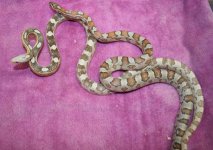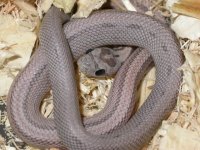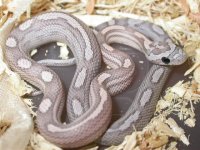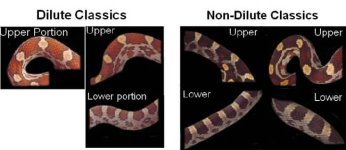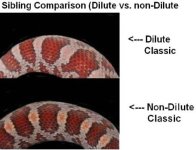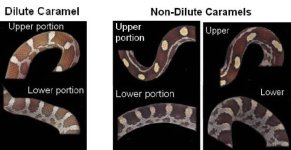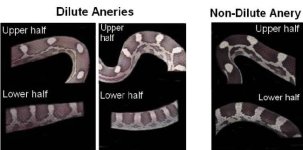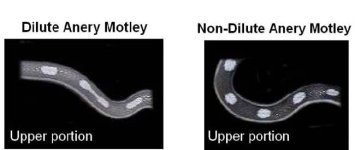but sunkisseds definitely are as much a pattern gene as a hypo gene....
It appears that Dilute is, also, more than only a Hypo gene.
Dilute is not limited to an affect upon melanin. It, also, appears that Dilute affects the expression of pigment (to different degrees).
Dilutes, also, do have, as Walter put it, a slight "haze" to the skin (which contributes to giving the snake a "softer" look). This "haze", or clear outer layer with the very slightest milky opacity, (not an easy thing to describe and, also, not an easy thing to photograph, but can be seen IRL) has led to some people describing Dilutes as having the appearance of a snake in perpetual shed (for the Anery based Dilutes, is my guess, since that description came about before other morph, & known, Dilutes were produced). I, personally, really dislike that description because a Dilute does not look like a snake that is, actually, in shed/blue.
But if dilute is acting as a hypo gene, why in the heck do so many people have such a hard time IDing them when compared to hypo A, or with no presence of hypo?
It should be relatively easy to pick out which hatchlings are Dilute and which are not.
Dilute Anery hatchlings stand out amidst non-Dilute hatchlings. Dilute Caramel hatchlings cannot, in any way, be confused with non-Dilute Caramel hatchlings. Dilute Classics, same thing.
Now, when there are Hypo A and Dilute hatchlings, in the same clutch, I can see where some folks may have a problem in identifying which may be Hypo A and which may be Dilute. However, I do believe that, for those with experience, this should not prove to be extraordinarily difficult (because there is a difference between the two morphs).
What I think would be hardest is to identify a hatchling that is homo for both Dilute & Hypo A from those hatchlings that are only Hypo A ... but I do not think it to be impossible.
What helps, with identification, is if there are other, non-Dilute, siblings in the clutch. However, again, with experience, identification becomes easier and, if there is no Hypo A (or other Hypo?) in the mix, identification should not pose a big problem either way.

